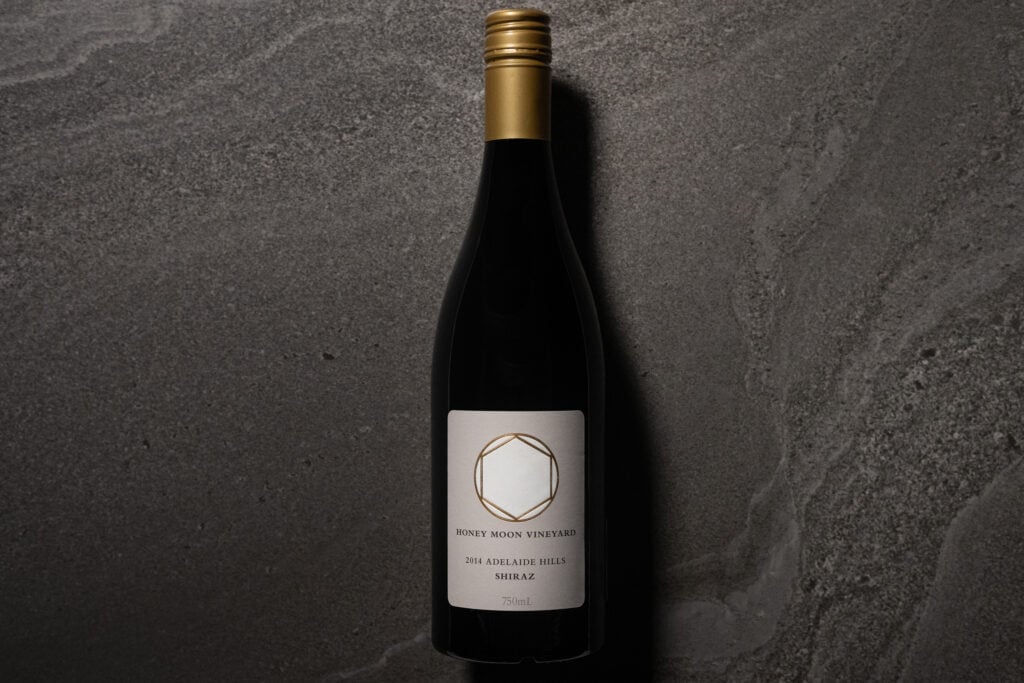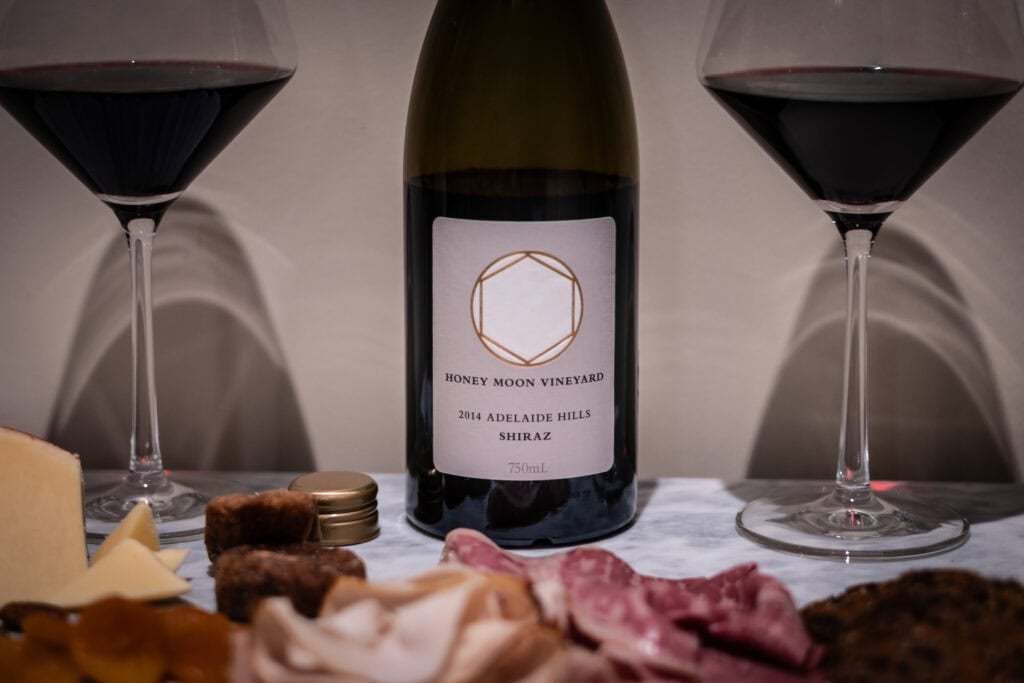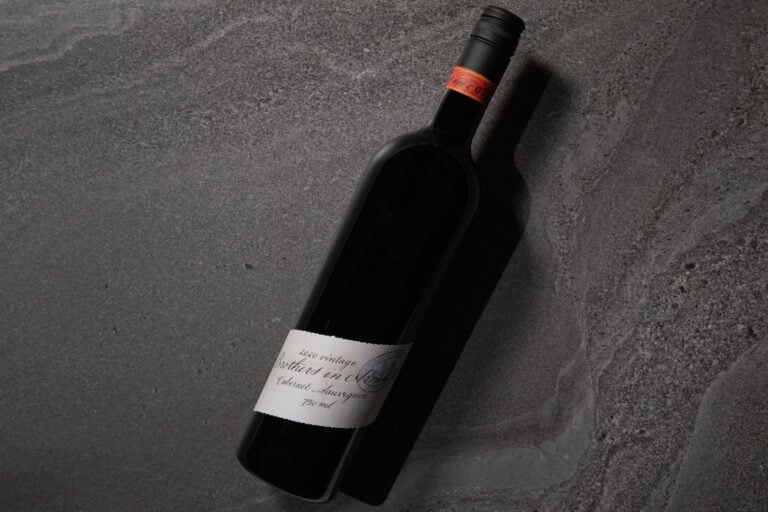Honeymoon Vineyard Shiraz 2014 Review – Aged Adelaide Hills Red with Measured Power

Ten years on, this small-production Shiraz from Honeymoon Vineyard still holds shape. Grown in Echunga, Adelaide Hills, the fruit comes from a cool-climate vineyard at 410–420m elevation on red ironstone clay—its sunny northeast-facing slope often likened to Côte Rôtie in ripening profile.
The label is simple. The vintage, 2014, was small and slow to ripen. We opened the bottle unsure what would remain—fruit, structure, or just the memory of both.
|
Vintage: |
2014 |
|
Region: |
Adelaide Hills, SA |
|
Varietal: |
Shiraz |
|
ABV: |
15% |
|
RRP: |
$35 AUD |
|
Format: |
750mL |
Appearance
In the glass, this ten-year-old Shiraz shows a deep ruby core with only light bricking at the rim. It’s more vibrant than muted, suggesting it has aged gracefully without slipping fully into tertiary territory. Light still passes easily through the edge.
Legs are thick and fall at a medium pace, forming steady trails down the inside of the glass. The overall impression is of a wine that has kept its shape with time.
Aroma / Nose
Oak and spice take the lead: warm and savoury, but not smoky. There’s a gentle dryness, as if the wine has eased into its secondary phase without any harshness. No burn from the alcohol, just a quiet sense of structure underneath.
With a swirl, fruit begins to emerge: plum and dark cherry, maybe even a flicker of blueberry or raspberry. It nods to a cool-climate fruit profile and reveals itself gradually. The transition from oak to fruit feels deliberate—more unfolding than bursting.
Palate / Taste
On the palate, the fruit speaks first. And it stays. Plum and dark cherry coat the mouth with a ripe, lasting presence that doesn’t fade after the first sip. There’s a quiet generosity here: not explosive, but sustained and well-integrated.
Tannins are grippy but restrained, mostly felt through the cheeks and gums rather than the tongue. They offer structure without drying out the experience. As the glass evolves, the oak begins to assert itself more clearly: toast and spice, well-paced, never dominant.
At 15%, the alcohol makes itself known with a low, steady warmth. It doesn’t spike or sting, but it does leave a gentle heat in the chest after swallowing. The overall balance leans toward boldness, with just enough composure to keep it from tipping over.
Despite the weight, it remains surprisingly easy to sip without food. It holds its own and doesn’t demand a plate to feel complete.
Finish
The finish is shaped by oak and gentle tannin, with fruit lingering softly beneath. A subtle, mouth-coating dryness closes the arc of flavour. It doesn’t feel abrasive—more like a full stop. Warmth, structure, and a trace of cool-climate red fruit are what remain.
Food Pairing

We tasted this 2014 Shiraz alongside a range of bites to see where it leaned.
Edam cheese worked best. It lifted a flash of fruit and freshness before letting oak take the reins. The cheese’s subtle smokiness also came forward, enhanced by the wine’s structure.
Persian fetta shifted the balance. Fruit retreated almost entirely, leaving oak and tannins in focus. The result was more angular: less layered, more structural.
With roast boneless chicken slices, the wine doubled down on oak. It held weight but offered little fruit in return, leaving the Shiraz feeling more forceful than fluid.
Wagyu beef slices brought the closest return to balance. The fat content helped reset the palate, allowing a bit more fruit to reappear. Still, oak remained the central note.
Cranberry and sunflower seed crackers, topped with fig and Persian fetta, introduced a flicker of fruit around the tongue. It was textural and slightly unexpected, showing the wine’s adaptability when the right elements align.
Hommus and crackers gave a sweeter entry, but the oak and tannin quickly surged at the front of the palate. It didn’t clash, but it didn’t soften the wine either.
Across the board, this Shiraz does better with bold, salty, or aged accompaniments. Cheeses and richer meats draw out its best character. Lighter flavours tend to give way to its oak-forward frame.
ATC Verdict: Is It Worth the Splurge?
This bottle was worth opening. It held its age with quiet authority. The fruit is still intact, the oak remains structured, and the alcohol, while present, never overstepped. It feels like a wine that could continue to evolve, though whether it deepens in complexity or simply softens over time is hard to say.
We wouldn’t call it essential, but we wouldn’t overlook it either. This is a small, focused producer making a serious cool-climate Shiraz: unflashy, grounded, and aging with integrity. We’d be curious to try something else from the label, especially a younger vintage or a different varietal.
Not loud. Not forgettable. Just steady, honest winemaking that earns a second look.

Editor’s Note
All tasting notes reflect the wine’s condition at the time of tasting in September 2025, not the winemaker’s original description.
This bottle wasn’t opened for show. It was opened to see what remained. And what remained was fruit, structure, and a sense of clarity.
Not loud. Not forgettable. Just steady winemaking with something to say—if you’re still listening.
–Adrian – Editor at All That Is Cool
Please drink responsibly.
All alcohol reviews on All That Is Cool are intended for audiences aged 18+. We support mindful, moderate consumption and only feature bottles we’ve personally tasted and evaluated.






